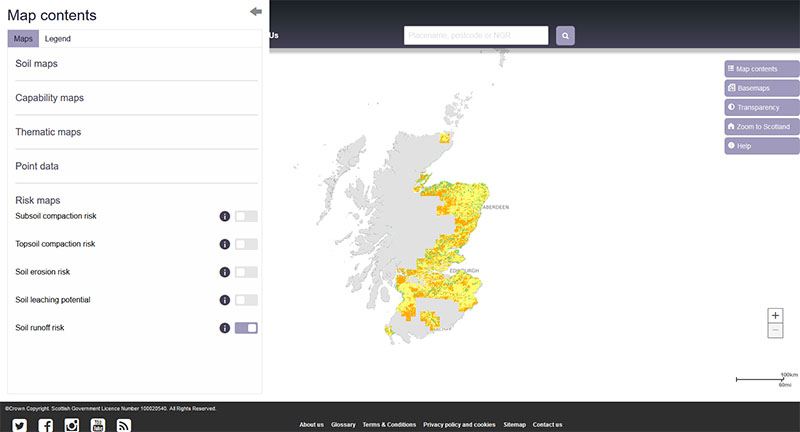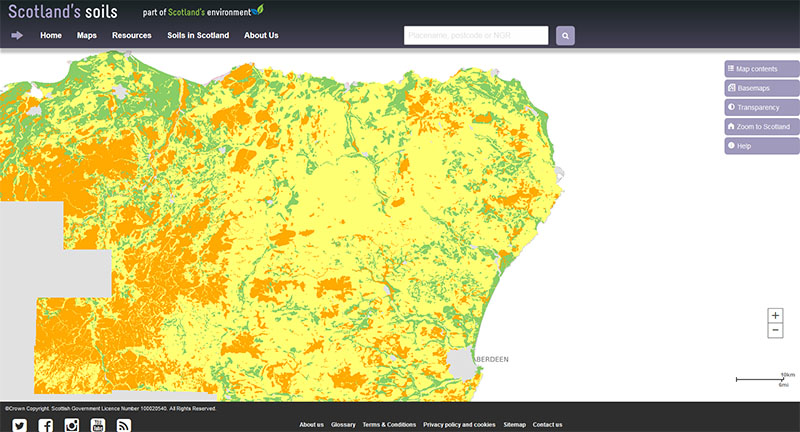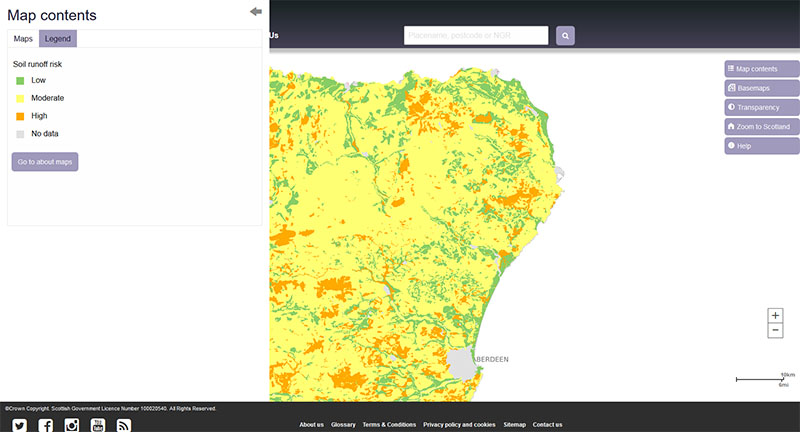View the map or download the data
What is it?
What do I see on my screen?
The map shows the risk of the soil becoming saturated, causing water (or any liquid applied to the soil) to flow over land (runoff) and carry potential pollutants into water courses, or to collect (pond) on the surface. It covers most of Scotland’s cultivated agricultural land area.
Map legend
The runoff risk is shown in 3 classes: Low, Moderate or High.
 |
Low runoff risk |
Soils can store large volumes of water or can allow water to quickly infiltrate and so surface runoff is limited. |
 |
Moderate runoff risk |
Soils have a moderate capacity to store rainfall or to allow water to infiltrate. Soils will reach saturation under some circumstances, leading to runoff. |
 |
High runoff risk |
Soils have a limited capacity to store rainfall or to allow water to infiltrate. The soil will quickly saturate, leading to rapid runoff. |
What is included in the digital dataset?
The digital dataset gives information on the likelihood of water (or another liquid applied to the soil) running off the land, and potentially carrying pollutants with it. The runoff risk is given in 3 classes: Low, Moderate or High.
The runoff risk classes also reflect a river's response to rainfall. Catchments dominated by soils with a high runoff risk tend to be flashy while those dominated by soils with a low runoff risk will tend to maintain flows during dry periods.
How was the map / dataset created?
The risk of runoff depends on how easily water can drain away from the soil surface. It also depends on how much water the soil can store. These in turn depend on fundamental soil characteristics such as porosity and flow pathways through the soil.
Each of the soils in the Soil Map of Scotland (partial cover) dataset was first allocated to one of 29 Hydrology of Soil Type (HOST) classes and then the Standard Percentage Runoff for these classes was determined from Boorman et al. (1995). These runoff values were then allocated to one of 3 classes that reflected the likelihood of a soil becoming saturated, potentially leading to water flowing over the land. The three classes, Low, Moderate or High, equate to less than 20, 20 to 40 and more than 40 percent runoff. Where the soil map units were described as complexes (that is, more than one soil type if found in a soil map unit), the precautionary principle was applied and the soil at most risk of generating runoff was used to describe the whole map unit.
How is it updated?
The map will be updated when new areas of digitised soil information become available.
Using the map
What can I do?
You can click on the map, or insert a grid reference or post code, to find out the risk of runoff occurring at that point. You can also download the map data from the James Hutton Institute data download page.
Be aware: This map is produced at a fixed scale; zooming-in does not change the resolution of the map.
Please cite as: Lilly, A. and Baggaley N.J. 2018. Runoff risk map of Scotland (partial cover). James Hutton Institute, Aberdeen.
This work was partly funded by the Rural & Environment Science & Analytical Services Division of the Scottish Government.
Technical and reference material
Boorman, D.B., Hollis, J.M and Lilly, A. 1995. Hydrology of soil types: a hydrologically-based classification of the soils of the United Kingdom. Institute of Hydrology Report No.126. Institute of Hydrology, Wallingford.
Lilly, A & Baggaley, N.J. 2014. Developing simple indicators to assess the role of soils in determining risks to water quality, CREW project number CD2012_42.
SSDI Metadata file
This page was last updated on 30 Jan 2020
Adobe Acrobat Reader is the free, trusted leader for reliably viewing, annotating and signing PDFs.
Download Adobe Acrobat Reader







